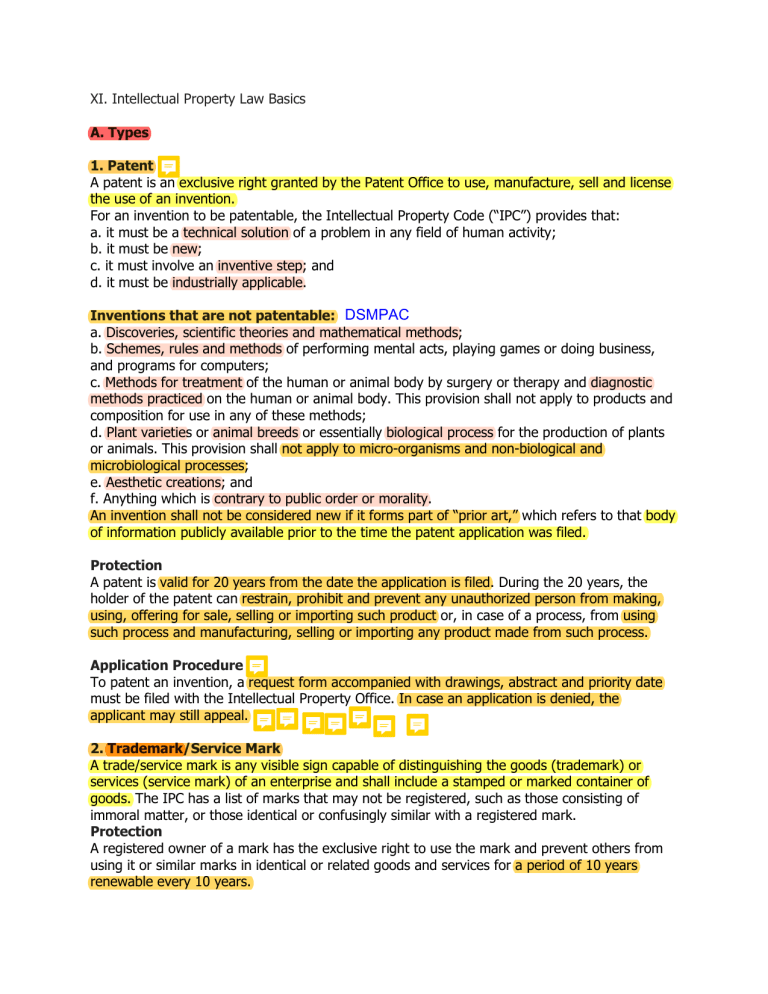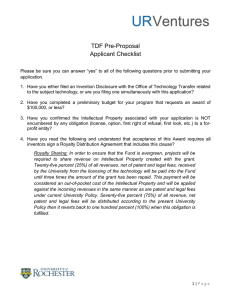Intellectual Property Law Basics: Patents, Trademarks, Copyrights
advertisement

XI. Intellectual Property Law Basics A. Types 1. Patent A patent is an exclusive right granted by the Patent Office to use, manufacture, sell and license the use of an invention. For an invention to be patentable, the Intellectual Property Code (“IPC”) provides that: a. it must be a technical solution of a problem in any field of human activity; b. it must be new; c. it must involve an inventive step; and d. it must be industrially applicable. Inventions that are not patentable: DSMPAC a. Discoveries, scientific theories and mathematical methods; b. Schemes, rules and methods of performing mental acts, playing games or doing business, and programs for computers; c. Methods for treatment of the human or animal body by surgery or therapy and diagnostic methods practiced on the human or animal body. This provision shall not apply to products and composition for use in any of these methods; d. Plant varieties or animal breeds or essentially biological process for the production of plants or animals. This provision shall not apply to micro-organisms and non-biological and microbiological processes; e. Aesthetic creations; and f. Anything which is contrary to public order or morality. An invention shall not be considered new if it forms part of “prior art,” which refers to that body of information publicly available prior to the time the patent application was filed. Protection A patent is valid for 20 years from the date the application is filed. During the 20 years, the holder of the patent can restrain, prohibit and prevent any unauthorized person from making, using, offering for sale, selling or importing such product or, in case of a process, from using such process and manufacturing, selling or importing any product made from such process. Application Procedure To patent an invention, a request form accompanied with drawings, abstract and priority date must be filed with the Intellectual Property Office. In case an application is denied, the applicant may still appeal. 2. Trademark/Service Mark A trade/service mark is any visible sign capable of distinguishing the goods (trademark) or services (service mark) of an enterprise and shall include a stamped or marked container of goods. The IPC has a list of marks that may not be registered, such as those consisting of immoral matter, or those identical or confusingly similar with a registered mark. Protection A registered owner of a mark has the exclusive right to use the mark and prevent others from using it or similar marks in identical or related goods and services for a period of 10 years renewable every 10 years. Application Same procedure as in the case of patents. 3. Copyright The works covered by the copyright law are generally creative works such as : a. Books, pamphlets, articles and other writings; b. Periodicals and newspapers; c. Lectures, sermons, addresses, dissertations prepared for oral delivery, whether or not reduced in writing or other material form; d. Letters; e. Dramatic or dramatico-musical compositions; choreographic works or entertainment in dumb shows; f. Musical compositions, with or without words; g. Works of drawing, painting, architecture, sculpture, engraving, lithography or other works of art; models or designs for works of art; h. Original ornamental designs or models for articles of manufacture, whether or not registrable as an industrial design, and other works of applied art; i. Illustrations, maps, plans, sketches, charts and three-dimensional works relative to geography, topography, architecture or science; j. Drawings or plastic works of a scientific or technical character; k. Photographic works including works produced by a process analogous to photography; lantern slides; l. Audiovisual works and cinematographic works and works produced by a process analogous to cinematography or any process for making audio-visual recordings; m. Pictorial illustrations and advertisements; n. Computer programs; and o. Other literary, scholarly, scientific and artistic works. The IPC also added derivative works to works that are protected by copyright. These are protected as new works without affecting the right of any subsisting copyright upon the original works. Works NOT covered by copyright: a. Unprotected Subject Matter IPSMC - PDMNO i. Idea; ii. Procedure; iii. System; iv. Method or operation; v. Concept; vi. Principle; vii. Discovery; viii. Mere data; ix. News of the day and other miscellaneous facts having the character of mere items of press information; and x. Any official text of a legislative, administrative or legal nature, as well as any official translation thereof. b. Works of the Government Protection Copyright shall consist of the exclusive right, for a period of 50 years after the death of the author, to carry out, authorize or prevent the following acts: a. Reproduction of the work or substantial portion of the work; b. Dramatization, translation, adaptation, abridgment, arrangement or other transformation of the work; c. The first public distribution of the original and each copy of the work by sale or other forms of transfer of ownership; d. Rental of the original or a copy of an audiovisual or cinematographic work, a work embodied in a sound recording, a computer program, a compilation of data and other materials or a musical work in graphic form, irrespective of the ownership of the original or the copy which is the subject of the rental; e. Public display of the original or a copy of the work; f. Public performance of the work; and g. Other communication to the public of the work. Procedure There is no need to register the work since copyright protection will begin from the moment of creation. However, the author, his assigns or heirs, may register it by filing a Registration and Deposit Form with any Intellectual Property Satellite Office together with the following documents: a. Affidavit evidencing ownership of the copyright or manner of its acquisition; b. Document evidencing identity of applicant; c. Document evidencing authority to represent (if the applicant is a representative); and d. Official Receipt of the filing fee; and the work to be deposited. 4. Trade Secrets A trade secret is any formula, pattern, device, or compilation of information that is used in one’s business and gives the owner an opportunity to obtain an advantage over competitors who do not possess the same information. Generally, a trade secret is a process or device intended for continuous use in the operation of the business. It can be a price list, catalogue or specialized customer list. Protection An employer can get an injunction to prevent the disclosure of a trade secret and file a case for damages against the person who made the unauthorized disclosure of the information. B. Protecting your Intellectual Property Non-disclosure Agreement (NDA) An NDA is a contract that contains conditions in relation to use and disclosure of confidential information to any person or the public. This is important in cases of intellectual properties that are not yet registered with the IPO because the protection given to undisclosed information cannot be obtained anymore if the information has become part of the public domain. Employee Rights to IP Absent any agreement between the parties, the employer will own the intellectual property of the employee if the work is commissioned or produced as part of the regular duties of the employee. To ensure that the employer will own the intellectual property right, this should be tackled in the employment agreement. C. Intellectual Property Related considerations for startups Open Source Licenses Open source software is software in which the source code is made freely available for the public to use, change, develop and add amendments. Open source licensing ensures ready use of protected technologies, creating a pool of core enabling technologies that are free for licensees to use as long as improvements to the core technology are also shared publicly. Software Patent Issue Philippine laws governing patents do not grant patents for computer software. It is subsumed under the copyright law. However, under certain circumstances, technology patents may be registered in the Philippines.


